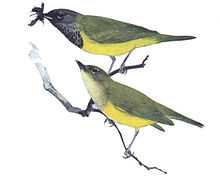MacGillivray's warbler
| MacGillivray's warbler | |
|---|---|
 | |
| MacGillivray's warbler by Bruce Horsfall | |
| Conservation status | |
| Scientific classification | |
| Kingdom: | Animalia |
| Phylum: | Chordata |
| Class: | Aves |
| Order: | Passeriformes |
| Family: | Parulidae |
| Genus: | Geothlypis |
| Species: | G. tolmiei |
| Binomial name | |
| Geothlypis tolmiei (Townsend, 1839) | |
| Synonyms | |
|
Oporornis tolmiei | |
The MacGillivray's warbler (Geothlypis tolmiei) is a small species of New World warbler. These birds are sluggish and heavy warblers with short tails, preferring to spend most of their time on, or near the ground, except when singing.
The MacGillivray's warbler was named by John James Audubon in honor of Scottish ornithologist William MacGillivray, although the proper credit to its discovery goes to John Kirk Townsend. The scientific name "tolmiei" was given in honor of William Fraser Tolmie.
Adult MacGillivray's warblers will grow to be approximately 13 cm {5 to 6 inches} in length. They are an olive-green color on their upperparts and dull yellow below. Males have black heads and breasts, while females and immature birds have drab light gray heads and white eye-rings. MacGillivray's warblers are almost identical to their eastern counterparts, the mourning warblers, the only true difference between the two species being the mourning warbler's lack of an eye-ring.
MacGillivray's warblers are migratory and spend their summers in temporate forests located in the western United States, and in boreal forests of west Canada. In autumn, these birds will migrate back to Central America, where they will stay in temperate shrublands for the winter.
| Wikimedia Commons has media related to Oporornis tolmiei. |
References
- ↑ BirdLife International (2012). "Oporornis tolmiei". IUCN Red List of Threatened Species. Version 2013.2. International Union for Conservation of Nature. Retrieved 26 November 2013.
| Wikisource has original text related to this article: |
External links
- MacGillivray's warbler - Oporornis tolmiei - USGS Patuxent Bird Identification InfoCenter
- MacGillivray's warbler Species Account - Cornell Lab of Ornithology
- MacGillivray's warbler videos on the Internet Bird Collection
- MacGillivray's warbler photo gallery VIREO
- Photo-High Res--(Close-up)
